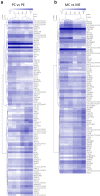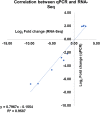Understanding seasonal weight loss tolerance in dairy goats: a transcriptomics approach
- PMID: 32928114
- PMCID: PMC7489022
- DOI: 10.1186/s12864-020-06968-2
Understanding seasonal weight loss tolerance in dairy goats: a transcriptomics approach
Abstract
Background: Seasonal weight loss (SWL) is a very important limitation to the production of ruminants in the Mediterranean and Tropical regions. In these areas, long dry seasons lead to poor pastures with low nutritional value. During the dry season, ruminants, particularly those raised in extensive production systems, lose around 30% of their body weight. Seasonal weight loss has important consequences on animal productive performance and health. In this study, RNA sequencing was used to characterize feed restriction effects in dairy goat of 2 breeds with different SWL tolerance: Majorera (tolerant) and Palmera (susceptible). Nine Majorera and ten Palmera goats were randomly distributed in a control and a restricted group: Majorera Control (adequately fed; MC; n = 4), Palmera Control (adequately fed; PC; n = 6), Majorera Restricted (feed restricted; ME; n = 5) and Palmera Restricted (feed restricted; PE; n = 4). On day 22 of the trial, mammary gland biopsies were collected for transcriptomics analysis.
Results: From these samples, 24,260 unique transcripts were identified. From those, 82 transcripts were differentially expressed between MC and ME, 99 between PC and PE, twelve between both control groups and twenty-nine between both restricted groups.
Conclusions: Feed restriction affected several biochemical pathways in both breeds such as: carbohydrate and lipid transport; intracellular trafficking, RNA processing and signal transduction. This research also highlights the importance or involvement of the genes in tolerance (ENPP1, S-LZ, MT2A and GPNB) and susceptibility (GPD1, CTPS1, ELOVL6 and NR4A1) to SWL with respectively higher expression in the Majorera restriced group and the Palmera restricted group in comparison to the control groups. In addition, results from the study may be extrapolated to other dairy ruminant species.
Keywords: Goat; Mammary gland; RNA-sequencing; Seasonal weight loss; Transcriptomics.
Conflict of interest statement
Authors declare no competing interests.
Figures







Similar articles
-
The goat (Capra hircus) mammary gland secretory tissue proteome as influenced by weight loss: A study using label free proteomics.J Proteomics. 2016 Aug 11;145:60-69. doi: 10.1016/j.jprot.2016.03.030. Epub 2016 Mar 24. J Proteomics. 2016. PMID: 27017928
-
Mammary gland and milk fatty acid composition of two dairy goat breeds under feed-restriction.J Dairy Res. 2017 Aug;84(3):264-271. doi: 10.1017/S0022029917000371. J Dairy Res. 2017. PMID: 28831968
-
Body live weight and milk production parameters in the Majorera and Palmera goat breeds from the Canary Islands: influence of weight loss.Trop Anim Health Prod. 2013 Nov;45(8):1731-6. doi: 10.1007/s11250-013-0423-2. Epub 2013 May 28. Trop Anim Health Prod. 2013. PMID: 23712398
-
Past, present, and future perspectives of small ruminant dairy research.J Dairy Sci. 2001 Sep;84(9):2097-115. doi: 10.3168/jds.S0022-0302(01)74655-3. J Dairy Sci. 2001. PMID: 11573791 Review.
-
Invited review: Current production trends, farm structures, and economics of the dairy sheep and goat sectors.J Dairy Sci. 2018 Aug;101(8):6715-6729. doi: 10.3168/jds.2017-14015. Epub 2018 May 30. J Dairy Sci. 2018. PMID: 29859690 Review.
Cited by
-
Unveiling the power of proteomics in advancing tropical animal health and production.Trop Anim Health Prod. 2024 Jun 3;56(5):182. doi: 10.1007/s11250-024-04037-4. Trop Anim Health Prod. 2024. PMID: 38825622 Review.
-
Nutritional Regulation of Mammary Gland Development and Milk Synthesis in Animal Models and Dairy Species.Genes (Basel). 2021 Apr 3;12(4):523. doi: 10.3390/genes12040523. Genes (Basel). 2021. PMID: 33916721 Free PMC article. Review.
-
Extensive Sheep and Goat Production: The Role of Novel Technologies towards Sustainability and Animal Welfare.Animals (Basel). 2022 Mar 31;12(7):885. doi: 10.3390/ani12070885. Animals (Basel). 2022. PMID: 35405874 Free PMC article. Review.
-
Functional and Genetic Insights into the Role of the NR4A1 Gene in the Litter Size of the Shaanbei White Cashmere Goat.Animals (Basel). 2025 Jun 11;15(12):1729. doi: 10.3390/ani15121729. Animals (Basel). 2025. PMID: 40564281 Free PMC article.
References
-
- Cardoso LA, Almeida AM. Seasonal weight loss - an assessment of losses and implications on animal welfare and production in the tropics: southern Africa and Western Australia as case studies. In: Harinder Makar PS, editor. Enhancing animal welfare and farmer income through strategic animal feeding. Rome: FAO; 2013. pp. 37–44.
-
- De Almeida AM, Cardoso LA. Animal production and genetic resources in Guinea Bissau: I – northern Cacheu Province. Trop Anim Health Prod. 2008;40:529–536. - PubMed
-
- De Almeida AM, Cardoso LA. Animal production and genetic resources in Guinea Bissau: II – Tombali Province. Trop Anim Health Prod. 2008;40:537–543. - PubMed
-
- Almeida AM, Schwalbach LM, de Waal HO, Greyling JP, Cardoso LA. The effect of supplementation on productive performance of Boer goat bucks fed winter veld hay. Trop Anim Health Prod. 2006;38:443–449. - PubMed
-
- Almeida AM, Schwalbach LMJ, Cardoso LA, Greyling JPC. Scrotal, testicular and semen characteristics of young Boer bucks fed winter veld hay: the effect of nutritional supplementation. Small Rumin Res. 2007;73:216–220.
MeSH terms
Grants and funding
- PTDC/CVT/116499/2010 - Lactation and milk production in Goat (Capra hircus): identifying molecular markers underlying adaptation to seasonal weight loss/Fundação para a ciência e a tecnologia
- PD/BD/113474/2015/Fundação para a ciência e a tecnologia
- PhD holder contract (DL57)/Fundação para a ciência e a tecnologia
- GREEN-it: Bioresources for Sustainability" (UID/Multi/04551/2020)/Fundação para a ciência e a tecnologia
- LEAF - UID/AGR/04129/2020/Fundação para a ciência e a tecnologia
LinkOut - more resources
Full Text Sources
Medical
Molecular Biology Databases
Miscellaneous

